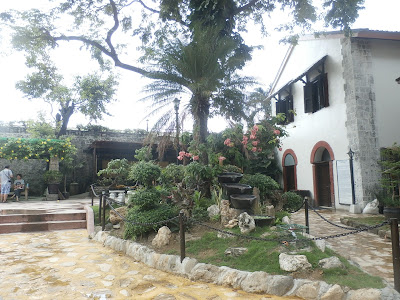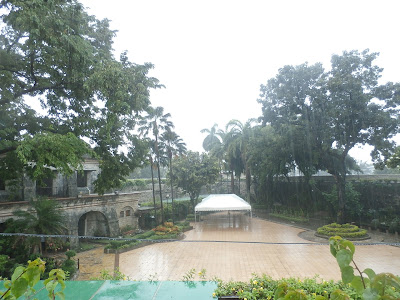PORT SAN PEDRO
Fuerte de San Pedro is a military defence structure in Cebu (Philippines), built by the Spanish under the command of Miguel López de Legazpi, first governor of the Captaincy General of the Philippines. The original fort was made of wood and built after the arrival of Legazpi and his expedition. In the early 17th century a stone fort was built to repel Muslim raiders. Today's structure dates from 1738 and is the oldest triangular bastion fort in the country. It served as the nucleus of the first Spanish settlement in the Philippines. During the Philippine Revolution at the end of the 19th century, it was attacked and taken by Filipino revolutionaries, who used it as a stronghold.
The fort is triangular in shape, with two sides facing the sea and the third side fronting the land. The two sides facing the sea were defended with artillery and the front with a strong palisade made of wood. The three bastions are named La Concepción (SW); Ignacio de Loyola (SE), and San Miguel (NE). It has a total inside area of 2,025 square metres (21,800 sq ft). The walls are 6.1 metres high by 2.4 metres thick (20 feet high by 8 feet thick), and the towers are 9.1 metres (30 ft) high from the ground level. The circumference is 380 metres (1,248 ft). The sides are of unequal lengths and the one fronting the city is where one may find entry into the fort. Fourteen cannons were mounted in their emplacements most of which are still there today. Work first started in 1565 with Miguel Lopéz de Legazpi breaking ground.
Little was known about the activity of the fort from the time it was built until two centuries later in 1739 when the King of Spain, Philip V, desired information regarding the island of Cebu. Governor-general Tamón, who was the Spanish ruler of the islands at the time made the following report:
The date of construction of the stone fort is uncertain, although there are claims that a Jesuit Antonio Campioni built a stone fort in 1630, and the gate of the fort bears the date 1738 together with the arms of Castile and Leon. It is certain, however, that the fort underwent major renovations in the late 19th century as part of a building program to improve Cebu.
The victory of the Americans led by Commodore Dewey at the Battle of Manila Bay in 1898 marked the end of the Spanish era in the Philippine Islands. The fort was then surrendered by the Spaniards to the Cebuano revolutionaries.
Fort San Pedro became a part of the American Warwick barracks during the American regime. From 1937 to 1941 the barracks was converted into a school where many Cebuanos received their formal education. During World War II from 1942 to 1945, Japanese residents of the city took refuge within the walls. When the battle to liberate the city of Cebu from the Imperial Japanese forces was fought, the fort served as an emergency hospital for the wounded.
From 1946 to 1950, Fort San Pedro was an army camp. After 1950, the Cebu Garden Club took over and fixed the inner part and converted it into a miniature garden.
Although already in ruins, the upper deck was utilized for different offices. First, as a clinic of the City Health, as office of the Presidential Arm and Community Development then the City Public Works Unit used the ruins of the lieutenant's quarters as its field office.
The Fort San Pedro restoration was a tedious, time and labor consuming project. To restore the fort as close to the original as possible, coral stones which were hauled from under the sea along Cebu coastal towns were utilized. Delivered crudely cut to the restoration site, the fort laborers did the final cutting and polishing to make the blocks fit each other.
Work progressed slowly but the facade, the main building, (Cuerpo de Guardia), the walk and the observatory roof garden were faithfully restored after one and a half years. To make the project functional; the restored main building serves then as the Cebu Office of the Department of Tourism, the lieutenant's quarters now houses a museum, the inner court is an open air theater and its immediate vicinity is a park.
At present, it is under the care and administration of the city of Cebu, as a historical park under City Executive Order No. 08-87 of February 20, 2008. This order also known as Plaza Independencia - Fort San Pedro Interim Policy and Advisory Board (PIFSIPAB) appointed Hon. Michael L. Rama as overall overseer of the Plaza Independencia and Fort San Pedro. The land on which it is situated is, however, owned by the Department of Environment and Natural Resources.
These days, part of the fort is a museum. Inside the fort houses the legacies of the Spanish Government: well preserved Spanish artifacts such as Spanish documents, paintings and sculpture. A large statue of Legazpi and Antonio Pigafetta may be seen outside the fort walls.
ENTRANCE FEE PHP30/PAX
INSIDE PORT SAN PEDRO AT THE LOWER GROUND AREA
PORT SAN PEDRO AT THE UPPER AREA
CANNONS FACING AT THE LAND AND SEA
HOW TO GET THERE?
--from the down town area ( colon ) ride a jeep going to SM / pier 1,2,3,4 just tell the driver to drop you off at the port san perdo ( fare Php7 )
PLAZA INDEPENDENCIA
A place wherein you can take a walk or jog, or just take a time to relax at the park. for some student this is a place to them to practice some dance rehearsal or school activities.
the park is surrounded by old trees. fresh scenery
they have a play ground area for the kids and kids at heart.
HOW TO GET THERE?
--Plaza independencia is just in-front of port san pedro.
so you can take a side trip walk here if you visited port san pedro.
EXPLORE MORE THE PROVINCE OF CEBU
CLICK MY LINK: http://angel-celynrejusogmailcom.blogspot.com/2015/08/getting-to-cebu-explore-island-paradise.html









































No comments:
Post a Comment